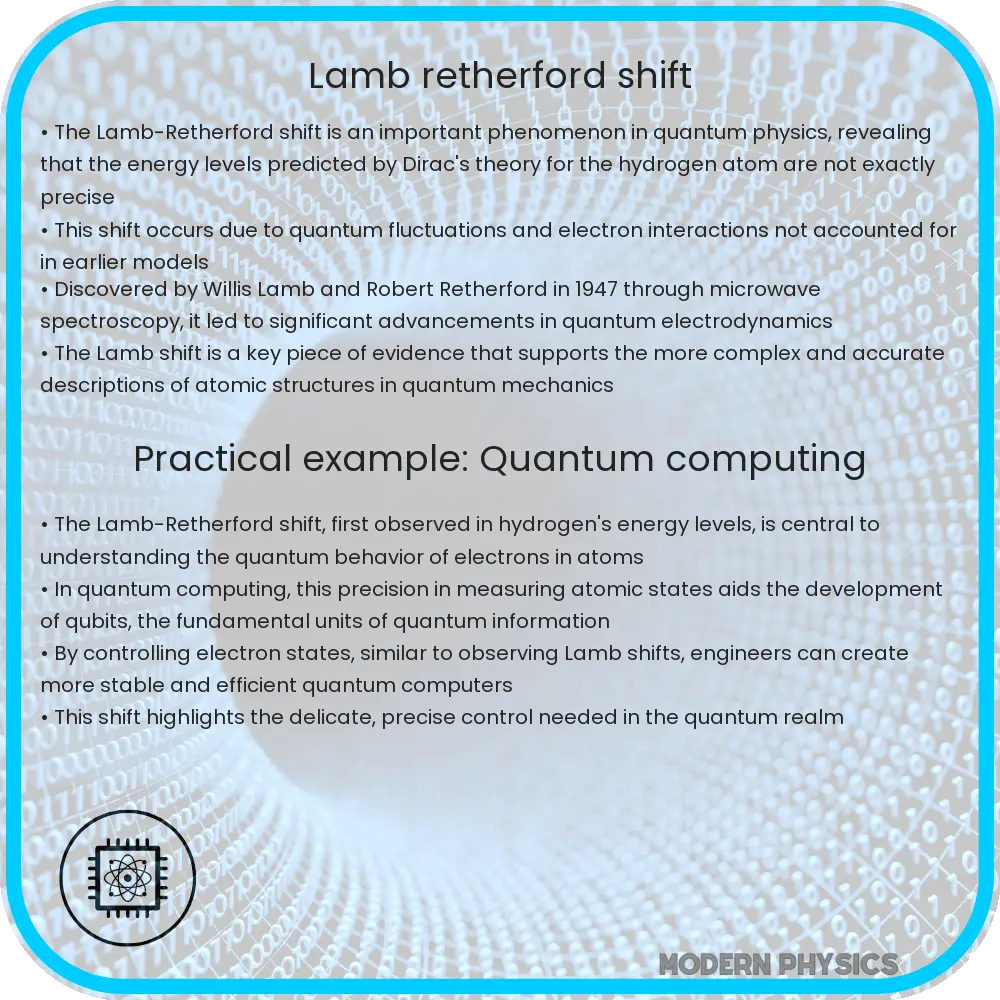Explore the Lamb-Retherford shift and its profound impact on quantum electrodynamics, revealing intricacies in photon-electron interactions.

Lamb-Retherford Shift: Unveiling the Nuances of Quantum Electrodynamics
The Lamb-Retherford shift, a phenomenon in quantum electrodynamics (QED), provides a pivotal insight into the subtle interactions between electrons and photons. This shift, discovered by Willis Lamb and Robert Retherford in 1947, revealed discrepancies in the energy levels of hydrogen atoms that classical quantum mechanics couldn’t explain. It paved the way for a deeper understanding of QED, the quantum theory that describes how light and matter interact.
Understanding the Basics: Quantum Electrodynamics and the Lamb-Retherford Shift
Quantum Electrodynamics (QED) is a cornerstone of modern physics, articulating the quantum theory governing the interaction of light (photons) with matter (specifically electrons). The Lamb-Retherford shift serves as a landmark evidence for QED’s predictions, showcasing the nuanced interactions that occur in the quantum realm. This shift particularly manifests in the hydrogen atom, the simplest atom consisting of one proton and one electron.
In classical quantum mechanics, the energy levels of an electron in a hydrogen atom are defined by its principal quantum number (n) and orbital angular momentum quantum number (l). However, Lamb and Retherford observed that the 2S1/2 and 2P1/2 energy levels of the hydrogen atom, which should be degenerate (having the same energy) according to the Dirac equation, were actually slightly different. This discrepancy, though tiny, was significant and pointed towards a deeper, more complex interaction at play.
The Role of Vacuum Fluctuations and Self-Energy in the Lamb Shift
The explanation for the Lamb-Retherford shift lies in the concepts of vacuum fluctuations and electron self-energy, two fundamental aspects of QED. Vacuum fluctuations refer to the temporary changes in energy that occur in empty space due to the creation and annihilation of particle-antiparticle pairs. These fluctuations affect the electron in the hydrogen atom, slightly altering its energy levels.
Furthermore, the concept of self-energy, which describes the interaction of an electron with its own electromagnetic field, also contributes to this shift. An electron emits and reabsorbs virtual photons, causing a change in its energy state. This self-interaction is a unique prediction of QED and plays a crucial role in explaining the Lamb-Retherford shift.
Through precise experimental methods and advanced theoretical calculations, scientists have been able to measure and predict the Lamb shift, affirming the accuracy and power of QED. This shift not only underscores the complex nature of photon-electron interactions but also highlights the precision required in quantum physics experiments.
Experimental Validation and Implications of the Lamb-Retherford Shift
The experimental verification of the Lamb-Retherford shift was a significant achievement in physics. It was one of the first precise tests of QED. Using a sophisticated microwave technique, Lamb and Retherford were able to measure the energy difference between the 2S1/2 and 2P1/2 states with remarkable accuracy. This experiment not only confirmed the predictions of QED but also necessitated revisions to the existing quantum theory, particularly the Dirac equation for the electron.
The accuracy of these measurements has only improved over time with technological advancements. Modern experiments use techniques like laser spectroscopy to achieve even more precise measurements. These ongoing efforts not only validate the Lamb-Retherford shift but also test the limits of QED and our understanding of fundamental physics.
The Broader Impact on Physics and Beyond
The implications of the Lamb-Retherford shift extend beyond the realms of atomic physics and QED. This discovery has influenced the development of more advanced theories, including the electroweak theory and quantum chromodynamics, which are integral parts of the Standard Model of particle physics. It also plays a role in precision tests of the Standard Model, helping physicists search for new physics beyond what is currently known.
In addition, the techniques and principles derived from studying the Lamb-Retherford shift have applications in other fields. For instance, the precision measurement techniques are crucial in timekeeping and GPS technology. The shift also has implications in quantum computing and information theory, where understanding the quantum behavior of particles is essential.
Conclusion
In summary, the Lamb-Retherford shift is a cornerstone discovery in quantum electrodynamics and a testament to the intricate nature of the quantum world. It challenged and refined our understanding of photon-electron interactions, leading to significant advancements in theoretical and experimental physics. This shift not only exemplifies the predictive power of QED but also underscores the continuous quest for precision in the scientific exploration of the universe. As research progresses, the Lamb-Retherford shift remains a fundamental reference point in the ongoing journey to unravel the mysteries of the quantum realm.
